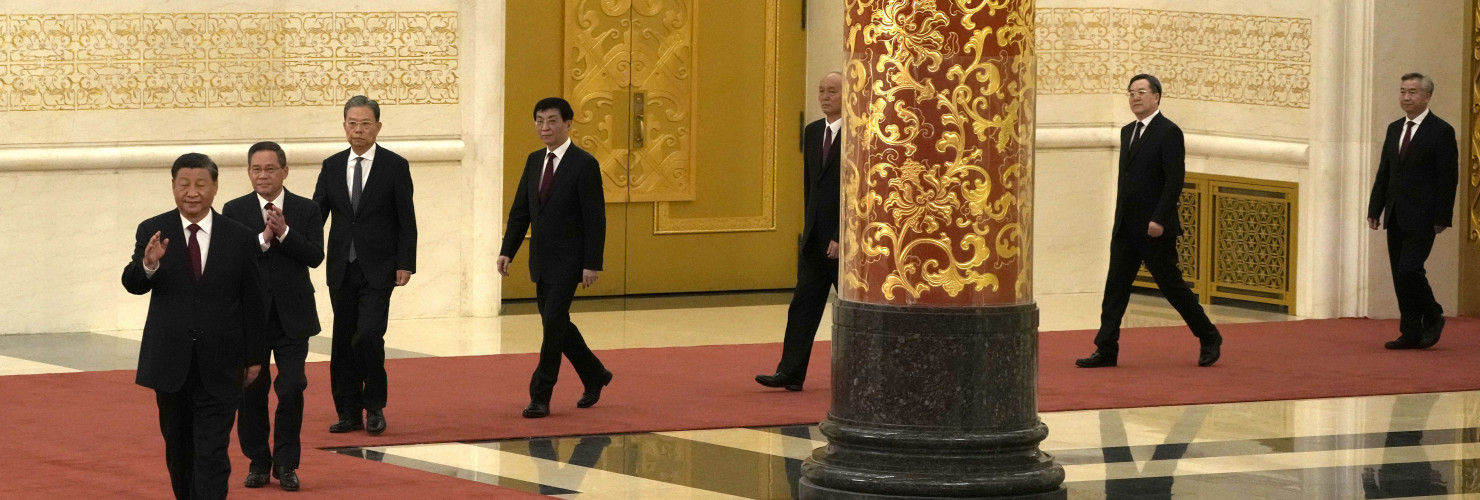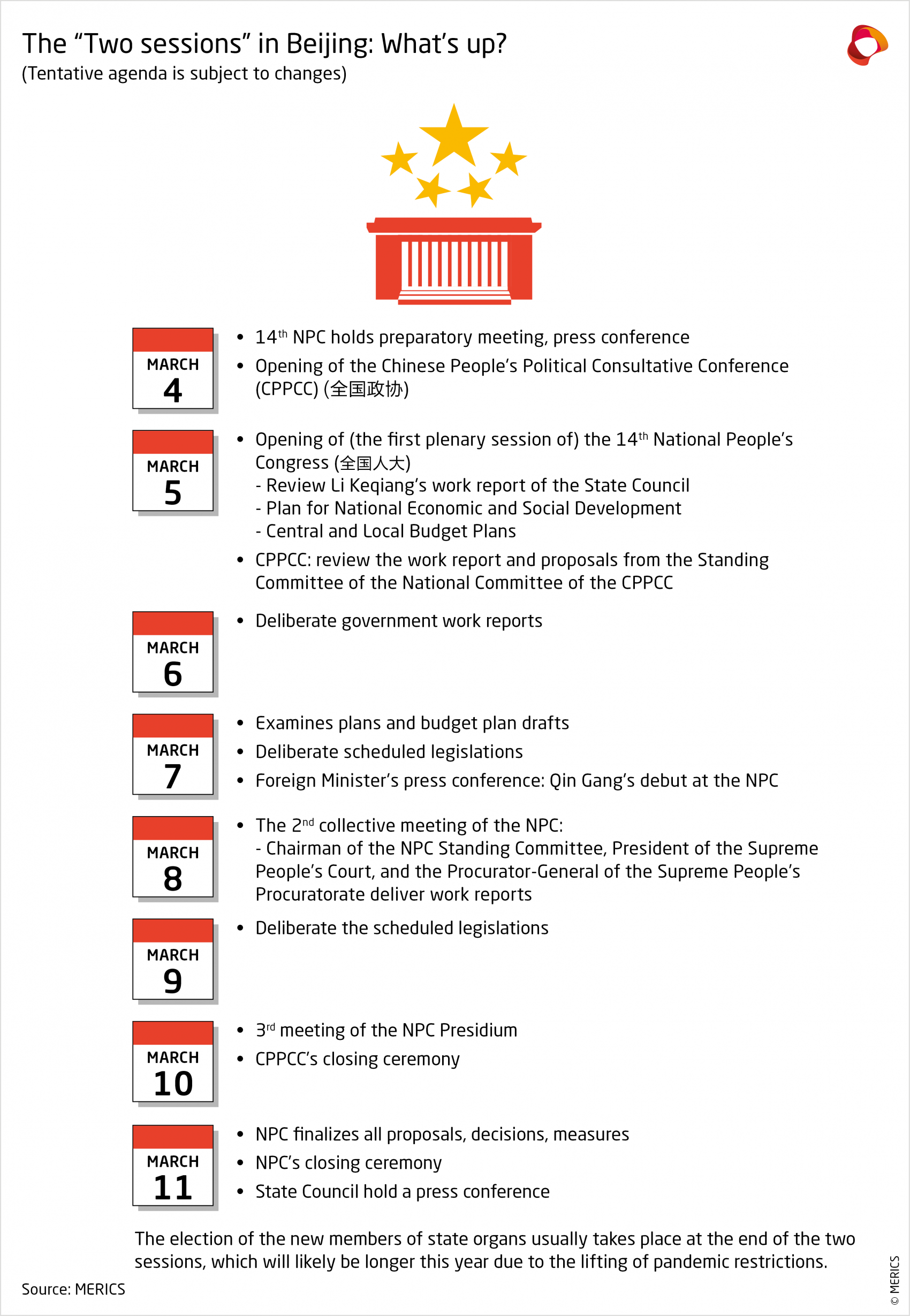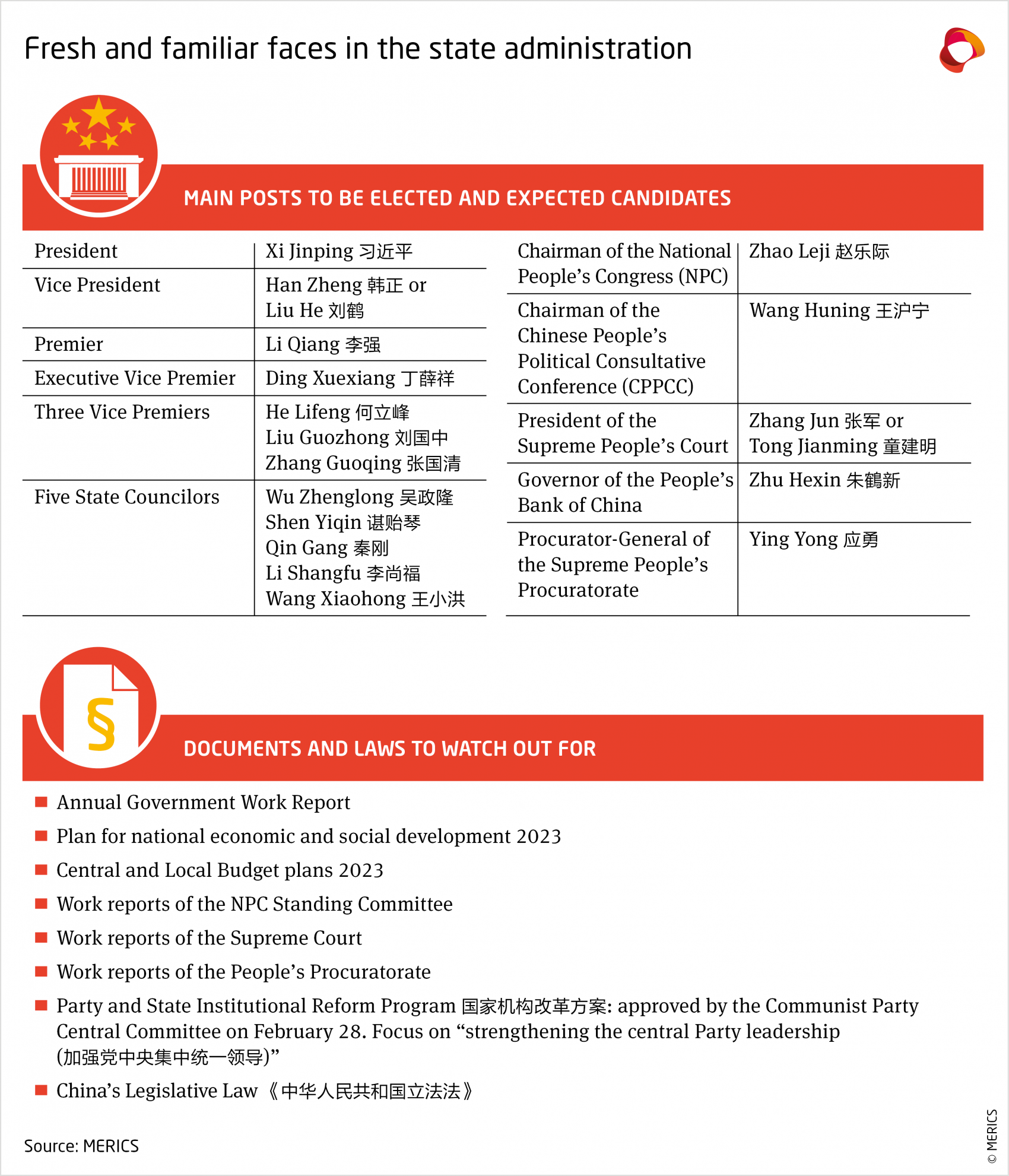

National People's Congress + Beijing sanctions two US companies + Basic research
Top story
NPC convenes to make over China’s government for President Xi’s third term
The National People’s Congress (NPC) will meet from March 5 to appoint the government’s top officials, make changes to its administrative structure and pass laws as its 14th legislative period begins. After the five-yearly National Congress of the Chinese Communist Party (CCP) last October, the annual gathering of the NCP is all but certain to replace Premier Li Keqiang and Executive Vice Premier Han Zheng with Li Qiang and Ding Xuexiang, close allies of Xi Jinping that were promoted to top CCP positions last fall. The 2,977 delegates are also expected to unanimously confirm Xi as president for the third term he long coveted.
Outgoing Premier Li Keqiang will present his final Government Work Report on the NPC’s opening day, detailing policy priorities and economic targets for the year ahead. He is expected to set a target of “about 5 percent” for growth of gross domestic product (GDP), after the economy grew 3 percent last year. The NPC is expected to sign off on military spending, the government budget and set the tone for economic policy in the year ahead. The Chinese People's Political Consultative Conference will as usual meet in parallel to the NPC, which is why the meetings are also known as the “Two Sessions”.
As the appointment of Li Qiang suggests, Xi looks set to consolidate his power in China’s government by filling key posts with trusted party allies and loyal state officials, including the National Development and Reform Commission (NDRC), the top economic-planning body, the People’s Bank of China (PBoC), the central bank, and the Ministries of Finance and of Science and Technology. Announcements suggest the new government will in the coming months concentrate on cleaning up the country’s financial sector.
The leadership will present the NPC with plans to reorganize party and state institutions. This will likely entail reshuffling ministries and the central administration, deepening the state's integration with the CCP, and possibly establishing new or upgrading existing party commissions. Financial and market regulators, ministerial portfolios in climate and technology and the security apparatus could also see changes, including centralization and party integration. The NPC is expected to amend China’s Legislation Law to further centralize law making and supervisory powers.
MERICS analysis: “The NPC concludes the appointment of key Xi Jinping loyalists in the state apparatus, giving the third-term president the confidence the administration will support his program,” says Nis Grünberg, MERICS Lead Analyst. “The administrative restructuring will further institutionalize CCP oversight over policymaking, with the areas financial policy and national security, in particular, being put on a shorter leash.”
Media coverage and sources:
- SCMP: China ‘two sessions’ 2023: Xi Jinping vows ‘forceful’ overhaul of finance and technology sectors
- WSJ: China to Shake Up Financial System as Xi Jinping Installs Key Associates
- Xinhua: 中国共产党第二十届中央委员会第二次全体会议公报
METRIX
8,000
This is the number of parliamentarians and staffers who were ordered by the European Parliament this week to delete the controversial social media app TikTok from their corporate digital devices by March 20. The parliament has joined the European Commission and Council who had previously banned the use of the app over cybersecurity concerns. In the US, the White House banned the app from all federal devices, adding to bans by individual US government agencies.
Media coverage and sources:
Topics
Beijing sanctions two US companies, using new “Unreliable Entities List” for first time
The facts: On February 16, China’s Ministry of Commerce announced it would sanction American companies Lockheed Martin and Raytheon Missiles & Defense, citing arms sales to Taiwan. The aerospace firms are the first Beijing has added to its “Unreliable Entities List,” since its creation in 2020. The action severely restricts access to China’s market in terms of trade, investment and personnel movement, and it could include fines. Although Beijing gave arms sales to Taiwan as the reason, some observers have noted that the sanctions came right after the US shot down a Chinese balloon with a Lockheed Martin fighter jet and a Raytheon missile.
What to watch: While sanctioning two large American companies may appear to be a strong action, it actually reveals how limited China is by its tech trade needs. Rather than targeting Raytheon itself, Beijing put its subsidiary Raytheon Missiles & Defense on the list. This is likely because Raytheon is a supplier for China’s civilian aerospace sector. Lockheed Martin, on the other hand, is almost exclusively a defense contractor – in 2021, 35% of Raytheon’s sales were commercial, while only 1% of Lockheed Martin’s were, according to their annual reports. This demonstrates the limits of China’s growing retaliation toolkit, as Beijing is reluctant to impose more assertive measures on foreign suppliers of technologies the country is dependent on.
MERICS analysis: “Beijing’s willingness to wield instruments of economic coercion is limited by its tech dependencies – hence Raytheon’s subsidiary being added to the Unreliable Entities List, but not Raytheon itself,” said Jacob Gunter, Senior Analyst at MERICS. “As the US is likely to further ratchet up arms sales to Taiwan, Beijing will likely try to retaliate. If Beijing limits its response to companies that make those weapons, its measures will be largely symbolic, as American defense contractors do not sell much to China, and if they do, it tends to be high-tech commercial inputs that China’s civilian sector relies on.”
More on the topic:
- From opportunity to risk: The changing economic security policies vis-à-vis China. MERICS Report by Francesca Ghiretti
- Fasten your seatbelts: How to manage China’s economic coercion. MERICS Report by Aya Adachi, Alexander Brown and Max J. Zenglein
Media coverage and sources:
Politburo signals support for basic research and international research collaboration
The facts: China’s leaders are focusing on tech self-reliance. The most recent “collective study session” of the 24-member Politburo of the Chinese Communist Party (CCP) looked at basic research, after their first session of 2023 considered how to concentrate national resources around technological bottlenecks. The regular meetings allow invited experts to talk about issues of strategic importance. Xi Jinping used the latest gathering to remind the Politburo that strengthening basic research was an absolute necessity if China wanted to become self-reliant and a science and technology superpower. He also called for international collaboration in basic research, highlighting areas like climate change, energy security, biosecurity and space technology.
What to watch: The upcoming Government Work Report at the National People’s Congress (NPC) will likely stress the need to break foreign tech strangleholds. Ensuing personnel and institutional changes will signal how Beijing intends to implement its “new-style whole of nation”-approach to science and technology. Using the image of “walking on two legs”, Xi argued basic research should be both mission-driven and open-ended in order to dovetail with strategic priorities of party and state. Research funding is likely to rise so that China can raise basic-research spending from 6.3 percent of all research expenditure in 2022 to the current Five-Year Plan’s goal of 8 percent. China will also make more funding available to foreign researchers and encourage projects carried out by experts in different countries, said the Ministry of Science and Technology (MOST).
MERICS analysis: “Even basic research has become increasingly political,” says Jeroen Groenewegen-Lau, Head of the Science, Technology and Innovation Program at MERICS. “Chinese commentators point out that China needs basic research because its access to global knowledge and technology is under threat. Not all basic research is without risks: rather than green technology, the MOST touts artificial intelligence, quantum information and laser manufacturing as focus areas. It will be in Europe’s interests to work with Chinese researchers in some of these areas, with the right safeguards.”
Media coverage and sources:
- Xinhua (CN): 习近平在中共中央政治局第三次集体学习时强调 切实加强基础研究 夯实科技自立自强根基 (Xi Jinping stressed during the third collective study of the Political Bureau of the CPC Central Committee to effectively strengthen basic research and solidify the foundation of scientific and technological self-reliance and self-improvement)
- SCMP: China must push basic science to become tech power, Xi Jinping says in call to boost funding, global teamwork
- Chinese government website (CN): 国务院新闻办就“深入实施创新驱动发展战略 加快建设科技强国”举行发布会新闻发布 (The Information Office of the State Council press conference on "Deepening the implementation of the innovation-driven development strategy and accelerating the construction of a strong science and technology nation")
China’s peace proposal – a communication strategy towards the Global South
The facts: On February 23, the UN General Assembly again overwhelmingly condemned Russia’s invasion of Ukraine. Since the start of the war a year ago, only two countries have flipped to a pro-Russian stance, with abstentions largely steady. This indicates that Russian narratives about the war, which are backed by China and targeted at the Global South, have so far been ineffective in changing votes. Now, Beijing is determined to revamp its communication strategy, portraying itself as a responsible and proactive power for peace. In the week of the anniversary of Russia’s invasion, China released a position paper branded as a “peace proposal” and a concept paper specifying its Global Security Initiative (GSI).
What to watch: Unsurprisingly, the proposal has been dismissed by European Union and United States leaders. However, China is probably hoping for a warmer response from Global South countries affected by the war’s impact on food and energy prices. Scaling up “peace-focused” communication without providing real commitment to a constructive role in the peace process might be enough to capitalize on these sentiments. It could also shield Beijing from criticism of its support for Moscow. So far, official endorsements of the proposal have been limited to Iran, Kazakhstan and Belarus, but Beijing’s communication campaign can still pick up momentum and bring others on board.
MERICS analysis: “Beijing sees the war in Ukraine through the lens of its strategic competition with the US rather than as a standalone issue,” says Grzegorz Stec, Analyst at MERICS. “The peace proposal and Global Security Initiative documents are part of a wider communication strategy to present China as a force for positive change and to muster support for changes to the international order. In their criticism of China’s position paper, EU members need to consider that they are not the only – and probably not the main – audience.”
More on the topic:
- The peace plan that wasn't. Short analysis by Helena Legarda
Media coverage and sources:
- Financial Times: China’s support for Russia taints Ukraine ‘peace’ plan, western officials say
- South China Morning Post: US joins EU in rejecting Beijing’s peace proposal, sanctions more Chinese firms
- The Guardian: Chinese peace plan for Ukraine greeted cautiously by the west
- European Council on Foreign Relations: United West, Divided from the Rest: Global Public Opinion One Year Into Russia’s War on Ukraine
Review
Chinese Power and Artificial Intelligence, edited by William C. Hannas and Huey-Meei Chang (Routledge, 2023)
Beijing has designated artificial intelligence (AI) a key area in which the nation wants to be globally competitive and thrown the weight of the state behind turbocharging its growth. William C. Hannas and Huey-Meei Chang, researchers at Georgetown University’s Center for Security and Emerging Technology, have assembled contributions from 15 experts that give various insights into how China is going about realizing its aim – and how successful its efforts are proving. This book provides both an excellent overview of China’s AI landscape as well as a useful reference for future research.
The book begins with a look at the institutional and investment structures driving AI innovation in China. It details an intricate network of research entities, including universities, stand-alone laboratories and companies, and explains how the state has crafted policy and directed massive funding to support them. It also does not lose sight of additional measures, including educational programs to nurture talent and efforts to gain new expertise via foreign technology transfer.
China’s focused cultivation of AI research has yielded results. Research output shows the country as a top AI research contributor. In neuroscience, scientists are exploring the possibility of emulating human intelligence with AI. In biology, AI is being applied in fields ranging from genetically modified crops to precision medicine. China is also investing heavily in quantum computing, where advances could vastly improve computing power and boost AI research. While it still falls short in areas like AI software and advanced semiconductors, China’s trajectory towards AI leadership is robust.
The book also delves into the more alarming aspects of China’s AI development, such as leveraging machine vision and unmanned autonomous vehicles for military use and harnessing biometric and health data for domestic surveillance. The country’s efforts in AI safety and governance lag behind its technological breakthroughs. In spite or because of that, China is a formidable competitor in AI, the authors tell us. It’s time for the West to pay attention and cultivate its competitive advantages.
Reviewed by Wendy Chang, Intern, MERICS Science, Technology and Innovation Policy Program
MERICS China Digest
This is the second time in that ASML has levelled charges against Chinese entities. The Dutch company says it has initiated an internal review after reporting the breach. (23/02/15)
Chinese state media called the platform China’s first rival to the US chatbot ChatGPT. A sudden surge in traffic caused the chatbot to crash. (23/02/21)
According to the plan, Beijing aims to make significant progress in digitalization by 2025, and reach “world-leading levels” by 2035. (23/02/27)

